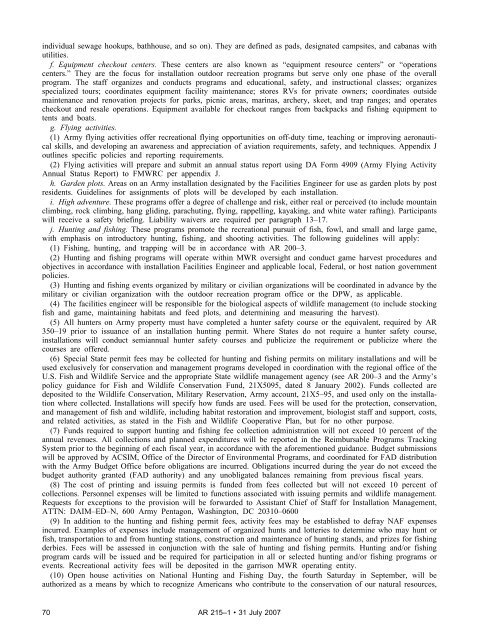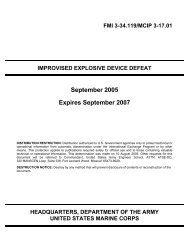AR 215-1 - Soldier Support Institute - U.S. Army
AR 215-1 - Soldier Support Institute - U.S. Army
AR 215-1 - Soldier Support Institute - U.S. Army
You also want an ePaper? Increase the reach of your titles
YUMPU automatically turns print PDFs into web optimized ePapers that Google loves.
individual sewage hookups, bathhouse, and so on). They are defined as pads, designated campsites, and cabanas with<br />
utilities.<br />
f. Equipment checkout centers. These centers are also known as “equipment resource centers” or “operations<br />
centers.” They are the focus for installation outdoor recreation programs but serve only one phase of the overall<br />
program. The staff organizes and conducts programs and educational, safety, and instructional classes; organizes<br />
specialized tours; coordinates equipment facility maintenance; stores RVs for private owners; coordinates outside<br />
maintenance and renovation projects for parks, picnic areas, marinas, archery, skeet, and trap ranges; and operates<br />
checkout and resale operations. Equipment available for checkout ranges from backpacks and fishing equipment to<br />
tents and boats.<br />
g. Flying activities.<br />
(1) <strong>Army</strong> flying activities offer recreational flying opportunities on off-duty time, teaching or improving aeronautical<br />
skills, and developing an awareness and appreciation of aviation requirements, safety, and techniques. Appendix J<br />
outlines specific policies and reporting requirements.<br />
(2) Flying activities will prepare and submit an annual status report using DA Form 4909 (<strong>Army</strong> Flying Activity<br />
Annual Status Report) to FMWRC per appendix J.<br />
h. Garden plots. Areas on an <strong>Army</strong> installation designated by the Facilities Engineer for use as garden plots by post<br />
residents. Guidelines for assignments of plots will be developed by each installation.<br />
i. High adventure. These programs offer a degree of challenge and risk, either real or perceived (to include mountain<br />
climbing, rock climbing, hang gliding, parachuting, flying, rappelling, kayaking, and white water rafting). Participants<br />
will receive a safety briefing. Liability waivers are required per paragraph 13–17.<br />
j. Hunting and fishing. These programs promote the recreational pursuit of fish, fowl, and small and large game,<br />
with emphasis on introductory hunting, fishing, and shooting activities. The following guidelines will apply:<br />
(1) Fishing, hunting, and trapping will be in accordance with <strong>AR</strong> 200–3.<br />
(2) Hunting and fishing programs will operate within MWR oversight and conduct game harvest procedures and<br />
objectives in accordance with installation Facilities Engineer and applicable local, Federal, or host nation government<br />
policies.<br />
(3) Hunting and fishing events organized by military or civilian organizations will be coordinated in advance by the<br />
military or civilian organization with the outdoor recreation program office or the DPW, as applicable.<br />
(4) The facilities engineer will be responsible for the biological aspects of wildlife management (to include stocking<br />
fish and game, maintaining habitats and feed plots, and determining and measuring the harvest).<br />
(5) All hunters on <strong>Army</strong> property must have completed a hunter safety course or the equivalent, required by <strong>AR</strong><br />
350–19 prior to issuance of an installation hunting permit. Where States do not require a hunter safety course,<br />
installations will conduct semiannual hunter safety courses and publicize the requirement or publicize where the<br />
courses are offered.<br />
(6) Special State permit fees may be collected for hunting and fishing permits on military installations and will be<br />
used exclusively for conservation and management programs developed in coordination with the regional office of the<br />
U.S. Fish and Wildlife Service and the appropriate State wildlife management agency (see <strong>AR</strong> 200–3 and the <strong>Army</strong>’s<br />
policy guidance for Fish and Wildlife Conservation Fund, 21X5095, dated 8 January 2002). Funds collected are<br />
deposited to the Wildlife Conservation, Military Reservation, <strong>Army</strong> account, 21X5–95, and used only on the installation<br />
where collected. Installations will specify how funds are used. Fees will be used for the protection, conservation,<br />
and management of fish and wildlife, including habitat restoration and improvement, biologist staff and support, costs,<br />
and related activities, as stated in the Fish and Wildlife Cooperative Plan, but for no other purpose.<br />
(7) Funds required to support hunting and fishing fee collection administration will not exceed 10 percent of the<br />
annual revenues. All collections and planned expenditures will be reported in the Reimbursable Programs Tracking<br />
System prior to the beginning of each fiscal year, in accordance with the aforementioned guidance. Budget submissions<br />
will be approved by ACSIM, Office of the Director of Environmental Programs, and coordinated for FAD distribution<br />
with the <strong>Army</strong> Budget Office before obligations are incurred. Obligations incurred during the year do not exceed the<br />
budget authority granted (FAD authority) and any unobligated balances remaining from previous fiscal years.<br />
(8) The cost of printing and issuing permits is funded from fees collected but will not exceed 10 percent of<br />
collections. Personnel expenses will be limited to functions associated with issuing permits and wildlife management.<br />
Requests for exceptions to the provision will be forwarded to Assistant Chief of Staff for Installation Management,<br />
ATTN: DAIM–ED–N, 600 <strong>Army</strong> Pentagon, Washington, DC 20310–0600<br />
(9) In addition to the hunting and fishing permit fees, activity fees may be established to defray NAF expenses<br />
incurred. Examples of expenses include management of organized hunts and lotteries to determine who may hunt or<br />
fish, transportation to and from hunting stations, construction and maintenance of hunting stands, and prizes for fishing<br />
derbies. Fees will be assessed in conjunction with the sale of hunting and fishing permits. Hunting and/or fishing<br />
program cards will be issued and be required for participation in all or selected hunting and/or fishing programs or<br />
events. Recreational activity fees will be deposited in the garrison MWR operating entity.<br />
(10) Open house activities on National Hunting and Fishing Day, the fourth Saturday in September, will be<br />
authorized as a means by which to recognize Americans who contribute to the conservation of our natural resources,<br />
70 <strong>AR</strong> <strong>215</strong>–1 • 31 July 2007

















